
List of non-extant papal tombs
Encyclopedia

Chronologically, the main locations of destroyed or unknown papal tombs have been: the obscure tombs of the first two centuries of popes near Saint Peter, the repeated waves of translations from the Catacombs of Rome
Catacombs of Rome
The Catacombs of Rome are ancient catacombs, underground burial places under or near Rome, Italy, of which there are at least forty, some discovered only in recent decades. Though most famous for Christian burials, either in separate catacombs or mixed together, they began in the 2nd century, much...
, the demolition of the papal tombs in Old St. Peter's Basilica
Papal tombs in Old St. Peter's Basilica
Papal tombs in Old St. Peter's Basilica were built from the fifth to sixteenth centuries. The majority of these tombs were destroyed during the sixteenth through seventeenth century demolition of Old St...
, and the 1306 and 1361 fires in the Basilica of St. John Lateran
Basilica of St. John Lateran
The Papal Archbasilica of St. John Lateran , commonly known as St. John Lateran's Archbasilica and St. John Lateran's Basilica, is the cathedral of the Diocese of Rome and the official ecclesiastical seat of the Bishop of Rome, who is the Pope...
.
Papal tombs have also been destroyed by other instances of fire, remodeling, and war (most recently, World War II
World War II
World War II, or the Second World War , was a global conflict lasting from 1939 to 1945, involving most of the world's nations—including all of the great powers—eventually forming two opposing military alliances: the Allies and the Axis...
). Others are unknown due to creative or geographically remote methods of martyr
Martyr
A martyr is somebody who suffers persecution and death for refusing to renounce, or accept, a belief or cause, usually religious.-Meaning:...
dom, or—in the case of Pope Clement I
Pope Clement I
Starting in the 3rd and 4th century, tradition has identified him as the Clement that Paul mentioned in Philippians as a fellow laborer in Christ.While in the mid-19th century it was customary to identify him as a freedman of Titus Flavius Clemens, who was consul with his cousin, the Emperor...
—both. Burial in churches outside the Aurelian Walls
Aurelian Walls
The Aurelian Walls is a line of city walls built between 271 and 275 in Rome, Italy, during the reign of the Roman Emperors Aurelian and Probus....
of Rome (Italian
Italian language
Italian is a Romance language spoken mainly in Europe: Italy, Switzerland, San Marino, Vatican City, by minorities in Malta, Monaco, Croatia, Slovenia, France, Libya, Eritrea, and Somalia, and by immigrant communities in the Americas and Australia...
: fuori le Mura)—in the basilicas of Paul
Basilica of Saint Paul Outside the Walls
The Papal Basilica of St Paul Outside the Walls , commonly known as St Paul's Outside the Walls, is one of four churches that are the great ancient major basilicas or papal basilicas of Rome: the basilicas of St. John Lateran, St. Mary Major, and St. Peter's and Saint Paul Outside the Walls...
or Lorenzo
San Lorenzo fuori le Mura
The Papal Basilica of Saint Lawrence outside the Walls is a Roman Catholic parish church and minor basilica, located in Rome, Italy. The basilica is one of the Seven Pilgrim Churches of Rome and one of the five Patriarchal basilicas, each of which is assigned to a patriarchate. St...
—have not generally survived.
Main locations
The main locations of destroyed or lost papal tombs include:- Saint Peter's tomb, around which the following popes were traditionally believed to have been buried: Pope LinusPope LinusPope Saint Linus was, according to several early sources, Bishop of the diocese of Rome after Saint Peter. This makes Linus the second Pope. According to other early sources Pope Clement I was the Pope after Peter...
, Pope AnacletusPope AnacletusPope Saint Anacletus , also called Pope Cletus, was the third Roman Pope Pope Saint Anacletus (very rarely written as Anencletus), also called Pope Cletus, was the third Roman Pope Pope Saint Anacletus (very rarely written as Anencletus), also called Pope Cletus, was the third Roman Pope (after St....
, Pope EvaristusPope EvaristusPope Saint Evaristus is accounted the fifth Pope, holding office from c. 99 to 107 AD or from 99 to 108. He was also known as Aristus....
. Pope TelesphorusPope TelesphorusPope Saint Telesphorus was Pope from 126 or 127 to 136 or 137 or 138, during the reigns of Roman Emperors Hadrian and Antoninus Pius. He was Greek by birth....
, Pope HyginusPope HyginusPope Saint Hyginus was bishop of Rome from about 136 or 138 to about 140 or 142. Tradition holds that during his papacy he determined the various prerogatives of the clergy and defined the grades of the ecclesiastical hierarchy...
, Pope Pius IPope Pius IPope Saint Pius I was Bishop of Rome, according to the Annuario Pontificio, from 142 or 146 to 157 or 161, respectively. Others suggest that his pontificate was perhaps from 140 to 154.-Early life:...
, Pope AnicetusPope AnicetusPope Saint Anicetus was Pope of the Catholic Church from about 150 to about 167 . His name is Greek for unconquered...
(later transferred to the Catacomb of CallixtusCatacomb of CallixtusThe Catacomb of Callixtus was one of the Catacombs of Rome on the Appian Way, most notable for containing the Crypt of the Popes , which contained the tombs of several popes from the 2nd to 4th centuries...
), Pope Victor IPope Victor IPope Saint Victor I was Pope from 189 to 199 .Pope Victor I was the first bishop of Rome born in the Roman Province of Africa: probably he was born in Leptis Magna . He was later canonized...
. Epigraphic evidence exists only for Linus, with the discovery of a burial slab marked "Linus" in 1615; however, the slab is broken such that it could have once read "Aquilinius" or "Anullinus". - The Catacombs of RomeCatacombs of RomeThe Catacombs of Rome are ancient catacombs, underground burial places under or near Rome, Italy, of which there are at least forty, some discovered only in recent decades. Though most famous for Christian burials, either in separate catacombs or mixed together, they began in the 2nd century, much...
, specifically the Catacomb of CallixtusCatacomb of CallixtusThe Catacomb of Callixtus was one of the Catacombs of Rome on the Appian Way, most notable for containing the Crypt of the Popes , which contained the tombs of several popes from the 2nd to 4th centuries...
, the Catacomb of PriscillaCatacomb of PriscillaThe Catacomb of Priscilla on the Via Salaria in Rome, Italy, is situated in what was a quarry in Roman times. This quarry was used for Christian burials from the late 2nd century through the 4th century. Some of the walls and ceilings display fine decorations illustrating Biblical scenes...
(and San Silvestro in CapiteSan Silvestro in CapiteThe Church of Saint Sylvester in Capite is a Roman Catholic minor basilica and titular church in Rome dedicated to Pope Saint Sylvester I. Built in the 8th century as a shrine for the relics of the saints and martyrs from the Catacombs, the church is the National church of Great Britain.The Latin...
, built over the catacomb), the Catacomb of BalbinaBalbinaMemorials of St. Balbina are to be found at Rome in three different spots which are connected with the early Christian antiquities of that city. In the purely legendary account of the martyrdom of St. Alexander mention is made of a tribune Quirinus who died a martyr and was buried in the catacomb...
, the Catacomb of CalepodiusCatacomb of CalepodiusThe Catacomb of Calepodius is one of the Catacombs of Rome, notable for containing the tombs of Pope Callixtus I and Pope Julius I, along with the eponymous Calepodius.Callixtus I was interred in the Catacomb of...
, the Catacomb of PontianCatacomb of PontianThe Catacomb of Pontian is one of the catacombs of Rome on the Via Portuensis, notable for containing the original tombs of Pope Anastasius I and his son Pope Innocent I...
, and the Catacomb of FelicitasFelicitas of RomeFelicitas of Rome is a saint numbered among the Christian martyrs. Apart from her name, the only thing known for certain about this martyr is that she was buried in the Cemetery of Maximus, on the Via Salaria on a 23 November. However, a legend presents her as the mother of the seven martyrs whose...
, which were emptied by repeated translations by the ninth century - Papal tombs in Old St. Peter's BasilicaPapal tombs in Old St. Peter's BasilicaPapal tombs in Old St. Peter's Basilica were built from the fifth to sixteenth centuries. The majority of these tombs were destroyed during the sixteenth through seventeenth century demolition of Old St...
, which once numbered over 100 papal tombs, nearly all of which were destroyed during the sixteenth/seventeenth century demolition - Basilica of St. John Lateran, where over a dozen tombs were destroyed in two fires (1308 and 1361)
1st century
| Pontificate | Portrait | Common English name | Tomb | Sculptor | Location | Notes |
|---|---|---|---|---|---|---|
| 88/92–97/101 | 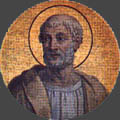 |
Clement I Pope Clement I Starting in the 3rd and 4th century, tradition has identified him as the Clement that Paul mentioned in Philippians as a fellow laborer in Christ.While in the mid-19th century it was customary to identify him as a freedman of Titus Flavius Clemens, who was consul with his cousin, the Emperor... Saint Clement |
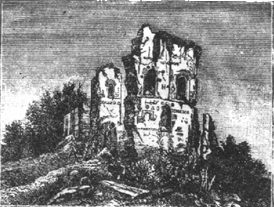 |
According to doctrine, translated to the Church of the Tithes Church of the Tithes The Church of the Tithes or Church of the Dormition of the Virgin was the first stone church in Kiev. It was built by the order of Grand Prince Vladimir the Great between 989 and 996 by Byzantine and local workers to commemorate the Baptism of Kievan Rus' and was originally named the "Church of... (Kiev) |
According to doctrine thrown into the Black Sea Black Sea The Black Sea is bounded by Europe, Anatolia and the Caucasus and is ultimately connected to the Atlantic Ocean via the Mediterranean and the Aegean seas and various straits. The Bosphorus strait connects it to the Sea of Marmara, and the strait of the Dardanelles connects that sea to the Aegean... near Crimea Crimea Crimea , or the Autonomous Republic of Crimea , is a sub-national unit, an autonomous republic, of Ukraine. It is located on the northern coast of the Black Sea, occupying a peninsula of the same name... , translated to the Church of the Holy Apostles Church of the Holy Apostles The Church of the Holy Apostles , also known as the Imperial Polyandreion, was a Christian church built in Constantinople, capital of the Eastern Roman Empire, in 550. It was second only to the Church of the Holy Wisdom among the great churches of the capital... , then Basilica di San Clemente Basilica di San Clemente The Basilica of Saint Clement is a Roman Catholic minor basilica dedicated to Pope Clement I located in Rome, Italy. Archaeologically speaking, the structure is a three-tiered complex of buildings: the present basilica built just before the year 1100 during the height of the Middle Ages; beneath... , then the Church of the Tithes. |
2nd century
| Pontificate | Portrait | Common English name | Tomb | Sculptor | Location | Notes |
|---|---|---|---|---|---|---|
| 105/107–115/116 |  |
Alexander I Pope Alexander I Pope Saint Alexander I was Bishop of Rome from about 106 to 115. The Holy See's Annuario Pontificio identifies him as a Roman who reigned from 108 or 109 to 116 or 119... Saint Alexander |
Competing claims (involving translation):
|
|||
| 115/116–125 | 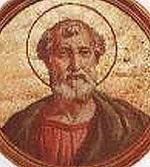 |
Sixtus I Pope Sixtus I Pope Saint Sixtus I was bishop of Rome from about 117 or 119 to 126 or 128 C.E., succeeding Pope Alexander I and succeeded by Pope Telesphorus. In the oldest documents, Xystus is the spelling used for the first three popes of that name.... Saint Sixtus |
Competing claims (involving translation and a finger):
Alatri Cathedral Alatri Cathedral, otherwise the Basilica of Saint Paul is the principal church of Alatri, Lazio, Italy. It is dedicated to Saint Paul. It was formerly the cathedral of the Diocese of Alatri, and since 30 September 1986 has been a co-cathedral of the Diocese of Anagni-Alatri... Alife Cathedral Alife Cathedral is a Roman Catholic cathedral in Alife in the province of Caserta, Campania, Italy. It is the seat of the Bishop of Alife-Caiazzo.... |
|||
| 174/175–189 | 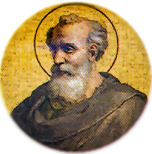 |
Eleuterus Pope Eleuterus Pope Saint Eleuterus, or Eleutherius, was Bishop of Rome from about 174 to 189 . He was born in Nicopolis in Epirus. His name is Greek for free.... Saint Eleutherus |
Competing claims:
Santa Susanna The Church of Saint Susanna at the baths of Diocletian is a Roman Catholic parish church on the Quirinal Hill in Rome, with a titulus associated to its site that dates back to about 280... (American Church in Rome) |
5th century
| Pontificate | Portrait | Common English name | Tomb | Sculptor | Location | Notes |
|---|---|---|---|---|---|---|
| 31 July 432–March/August 440 | 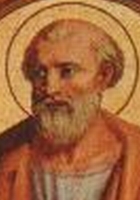 |
Sixtus III Pope Sixtus III Pope Saint Sixtus III was pope from 31 July 432 to 18 August 440.The name of Sixtus is often connected with a great building boom in Rome: Santa Sabina on the Aventine Hill was dedicated during his pontificate and he built Santa Maria Maggiore, whose dedication to Mary the Mother of God reflected... Saint Sixtus |
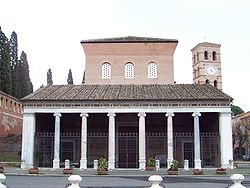 |
San Lorenzo fuori le Mura San Lorenzo fuori le Mura The Papal Basilica of Saint Lawrence outside the Walls is a Roman Catholic parish church and minor basilica, located in Rome, Italy. The basilica is one of the Seven Pilgrim Churches of Rome and one of the five Patriarchal basilicas, each of which is assigned to a patriarchate. St... |
Then called San Lorenzo al Verano; sarcophagus destroyed, possibly in 1943 | |
| 19 November 461 - 29 February 468 | .jpg) |
Hilarius Pope Hilarius Pope Saint Hilarius was Pope of the Roman Catholic Church from 461 to February 28, 468. He was canonized as a saint after his death.... Saint Hilarius |
 |
San Lorenzo fuori le Mura San Lorenzo fuori le Mura The Papal Basilica of Saint Lawrence outside the Walls is a Roman Catholic parish church and minor basilica, located in Rome, Italy. The basilica is one of the Seven Pilgrim Churches of Rome and one of the five Patriarchal basilicas, each of which is assigned to a patriarchate. St... , crypt |
Then called San Lorenzo al Verano | |
| 13 March 483 - 1 March 492 |  |
Felix III Pope Felix III Pope Saint Felix III was pope from March 13, 483 to january 3, 492. His repudiation of the Henoticon is considered the beginning of the Acacian schism.-Biography:... (Felix II) Saint Felix |
Either San Paolo fuori le Mura or the cyrpt of Santissima Concenzione near Piazza Barberini Piazza Barberini Piazza Barberini is a large piazza in the centro storico or city center of Rome, Italy and situated on the Quirinal Hill. It was created in the 16th century but many of the surrounding buildings have subsequently been rebuilt.... |
6th century
| Pontificate | Portrait | Common English name | Tomb | Sculptor | Location | Notes |
|---|---|---|---|---|---|---|
| 1 June 536 - 11 November 537 | 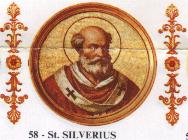 |
Silverius Pope Silverius Pope Saint Silverius was Pope from June 8, 536 until March 537. According to the "New Catholic Encyclopedia" , the dates of Pope Silverius' pontificate are in doubt: "June 1 or 8, 536, to c. November 11, 537; d. Palmaria, probably December 2, 537."... Saint Silverius |
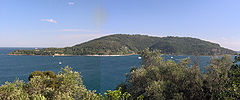 |
Palmaria Palmaria (island) Palmaria is an Italian island situated in the Ligurian Sea, at the westernmost end of the Gulf of La Spezia. Measuring 1.6 km², it is the largest island of an archipelago of three closely spaced islands jutting out south from the mainland at Portovenere... |
Non-contemporary shrine extant on Ponza Island Ponza Ponza is the largest of the Italian Pontine Islands archipelago, located 33 km south of Cape Circeo in the Tyrrhenian Sea. It also the name of the commune of the island, a part of the province of Latina in the Lazio region.... |
|
| 29 March 537 - 7 June 555 |  |
Vigilius Pope Vigilius Pope Vigilius reigned as pope from 537 to 555, is considered the first pope of the Byzantine Papacy.-Early life:He belonged to a aristocratic Roman family; his father Johannes is identified as a consul in the Liber pontificalis, having received that title from the emperor... |
Either San Marcello San Marcello al Corso San Marcello al Corso is a church in Rome, Italy, devoted to Pope Marcellus I. It is located in via del Corso, the ancient via Lata, connecting Piazza Venezia to Piazza del Popolo.... on the Via Salaria Via Salaria The Via Salaria was an ancient Roman road in Italy.It eventually ran from Rome to Castrum Truentinum on the Adriatic coast - a distance of 242 km. The road also passed through Reate and Asculum... (Oxford Dictionary of Popes) or San Silvestre San Silvestro in Capite The Church of Saint Sylvester in Capite is a Roman Catholic minor basilica and titular church in Rome dedicated to Pope Saint Sylvester I. Built in the 8th century as a shrine for the relics of the saints and martyrs from the Catacombs, the church is the National church of Great Britain.The Latin... over the Catacomb of Priscilla on the Via Salaria (Catholic Encyclopedia) |
7th century
| Pontificate | Portrait | Common English name | Tomb | Sculptor | Location | Notes |
|---|---|---|---|---|---|---|
| July 649 - 16 September 655 | 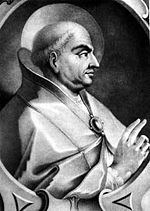 |
Martin I Pope Martin I Pope Martin I, born near Todi, Umbria in the place now named after him , was pope from 649 to 653, succeeding Pope Theodore I in July 5, 649. The only pope during the Byzantine Papacy whose election was not approved by a iussio from Constantinople, Martin I was abducted by Constans II and died in... Saint Martin |
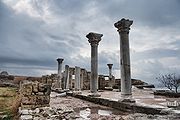 |
Church of our Lady (Blachdernæ), near Chersonesus | No trace of the Church or tomb remains |
9th century
| Pontificate | Portrait | Common English name | Tomb | Sculptor | Location | Notes |
|---|---|---|---|---|---|---|
| 25 January 817 - 11 February 824 | 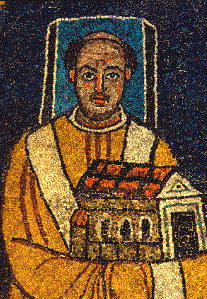 |
Paschal I Pope Paschal I Pope Saint Paschal I was pope from January 25, 817 to February 11, 824. A native of Rome and son of Bonosus, he was raised to the pontificate by the acclamation of the clergy, shortly after the death of Pope Stephen IV, and before the sanction of the emperor Louis the Pious had been obtained - a... Saint Paschal |
Unknown, but likely destroyed | Alleged to have been buried in the chapel of St. Zeno of Santa Prassade (disproved by modern research); possibly buried under the altar of the oratory of Saints Processus and Martiniano and lost when the oratory was moved in 1548 or 1605. |
10th century
| Pontificate | Portrait | Common English name | Tomb | Sculptor | Location | Notes |
|---|---|---|---|---|---|---|
| July 903–September 903 | 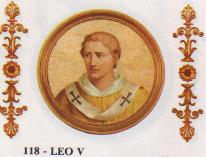 |
Leo V Pope Leo V Pope Leo V, a native of Ardea, was Pope for some thirty days in 903 after the death of Pope Benedict IV . He was dethroned by antipope Christopher , who is sometimes considered a legitimate pope. Elected while a priest, Leo V's pontificate occurred in the darkest period of papal history... |
Unknown but destroyed | Either cremated and thrown in the Tiber, buried (and thus destroyed) in Old Saint Peter's, or buried whole in Basilica of St. John Lateran Basilica of St. John Lateran The Papal Archbasilica of St. John Lateran , commonly known as St. John Lateran's Archbasilica and St. John Lateran's Basilica, is the cathedral of the Diocese of Rome and the official ecclesiastical seat of the Bishop of Rome, who is the Pope... |
||
| 1 October 965 - 6 September 972 | John XIII Pope John XIII Pope John XIII of Crescenzi family served as Pope from October 1, 965, until his death.Born in Rome, he spent his career in the papal court... |
 |
Basilica of Saint Paul Outside the Walls Basilica of Saint Paul Outside the Walls The Papal Basilica of St Paul Outside the Walls , commonly known as St Paul's Outside the Walls, is one of four churches that are the great ancient major basilicas or papal basilicas of Rome: the basilicas of St. John Lateran, St. Mary Major, and St. Peter's and Saint Paul Outside the Walls... |
Destroyed |
11th century
| Pontificate | Portrait | Common English name | Tomb | Sculptor | Location | Notes |
|---|---|---|---|---|---|---|
| June 1003–December 1003 |  |
John XVII Pope John XVII Pope John XVII , born John Sicco, and the son of another John Sicco, was born in the region of Rome then referred to as Biveretica... |
Unknown but destroyed | Either San Paolo fuori le Mura, Basilica of St. John Lateran Basilica of St. John Lateran The Papal Archbasilica of St. John Lateran , commonly known as St. John Lateran's Archbasilica and St. John Lateran's Basilica, is the cathedral of the Diocese of Rome and the official ecclesiastical seat of the Bishop of Rome, who is the Pope... or Santa Sabina Santa Sabina The Basilica of Saint Sabina at the Aventine is a titular minor basilica and mother church of the Roman Catholic Dominican order in Rome, Italy. Santa Sabina lies high on the Aventine Hill, beside the Tiber, close to the headquarters of theKnights of Malta.... |
||
| 25 December 1003–July 1009 |  |
John XVIII Pope John XVIII Pope John XVIII was Pope in Pisa from 1004 to 1009. He was born Fasanius at Rapagnano, near Ascoli Piceno, the son of a Roman priest named Leo.... |
Unknown but destroyed | Either San Paolo fuori le Mura or Basilica of St. John Lateran | ||
| 1032–1044 | 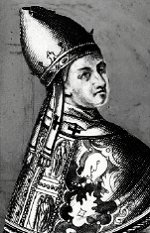 |
Benedict IX Pope Benedict IX Pope Benedict IX , born Theophylactus of Tusculum, was Pope on three occasions between 1032 and 1048. One of the youngest popes, he was the only man to have been Pope on more than one occasion and the only man ever to have sold the papacy.-Biography:Benedict was born in Rome as Theophylactus, the... |
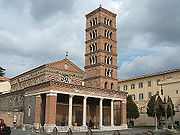 |
Abbey of Grottaferrata | Discovered on March 4, 1739; destroyed during World War II | |
| 1045 | 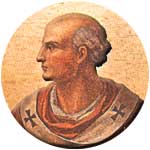 |
Sylvester III | Unknown | |||
| 13 April 1055–28 July 1057 |  |
Victor II Pope Victor II Pope Victor II , born Gebhard, Count of Calw, Tollenstein, and Hirschberg, was Pope from 1055 to 1057. He was one of a series of German reform Popes.-Life:... |
Santa Maria Rotunda (Ravenna) | Destroyed; claimed reburied in San Reparata (Florence) unsupported by evidence | ||
| 2 August 1057–29 March 1058 | 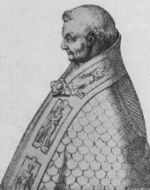 |
Stephen IX Pope Stephen IX Pope Stephen IX was Pope from August 3, 1057 to March 1058.His baptismal name was Frederick of Lorraine , and he was a younger brother of Godfrey III, Duke of Lower Lorraine, who, as Marquis of Tuscany , played a prominent part in the politics of the period.Frederick, who had... , O.S.B. Order of Saint Benedict The Order of Saint Benedict is a Roman Catholic religious order of independent monastic communities that observe the Rule of St. Benedict. Within the order, each individual community maintains its own autonomy, while the organization as a whole exists to represent their mutual interests... |
.jpg) |
Santa Reparata (Florence) | Tomb discovered in 1357 during the laying of the foundation for the new Duomo | |
| 6 December 1058–27 July 1061 |  |
Nicholas II Pope Nicholas II Pope Nicholas II , born Gérard de Bourgogne, Pope from 1059 to July 1061, was at the time of his election the Bishop of Florence.-Antipope Benedict X:... |
.jpg) |
Santa Reparata (Florence) | Possibly reburied in the outer left aisle of St. Peter's; no remains of tomb in either today | |
| 30 September 1061–21 April 1073 | 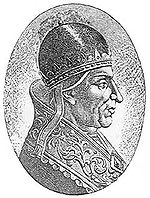 |
Alexander II Pope Alexander II Pope Alexander II , born Anselmo da Baggio, was Pope from 1061 to 1073.He was born in Milan. As bishop of Lucca he had been an energetic coadjutor with Hildebrand of Sovana in endeavouring to suppress simony, and to enforce the celibacy of the clergy... |
Unknown but lost | Either St. John Lateran or St. Peter's |
12th century
| Pontificate | Portrait | Common English name | Tomb | Sculptor | Location | Notes |
|---|---|---|---|---|---|---|
| 21 October 1187–17 December 1187 | 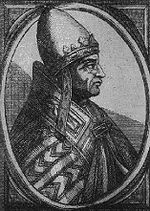 |
Gregory VIII Pope Gregory VIII Pope Gregory VIII , born Alberto di Morra, was Pope from October 25, 1187 until his death.-Early life:... , Can. Reg. |
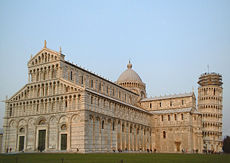 |
Pisa Cathedral, Chapel of Our Lady | Destroyed in the fire of 1600; ordered the desecration of the tomb of Antipope Victor IV in Lucca on his way to Pisa, where he died |
13th century
| Pontificate | Portrait | Common English name | Tomb | Sculptor | Location | Notes |
|---|---|---|---|---|---|---|
| 18 July 1216–18 March 1227 | 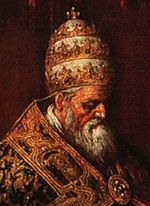 |
Honorius III Pope Honorius III Pope Honorius III , previously known as Cencio Savelli, was Pope from 1216 to 1227.-Early work:He was born in Rome as son of Aimerico... |
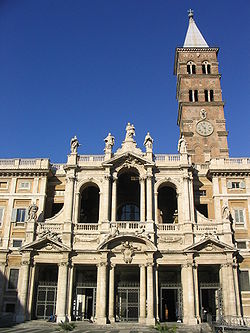 |
Basilica di Santa Maria Maggiore Basilica di Santa Maria Maggiore The Papal Basilica of Saint Mary Major , known also by other names, is the largest Roman Catholic Marian church in Rome, Italy.There are other churches in Rome dedicated to Mary, such as Santa Maria in Trastevere, Santa Maria in Aracoeli, Santa Maria sopra Minerva, but the greater size of the... |
No longer extant | |
| 12 December 1254–25 May 1261 | 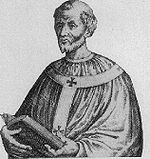 |
Alexander IV Pope Alexander IV Pope Alexander IV was Pope from 1254 until his death.Born as Rinaldo di Jenne, in Jenne , he was, on his mother's side, a member of the de' Conti di Segni family, the counts of Segni, like Pope Innocent III and Pope Gregory IX... |
 |
Viterbo Cathedral | Destroyed in 1490; no longer extant |

